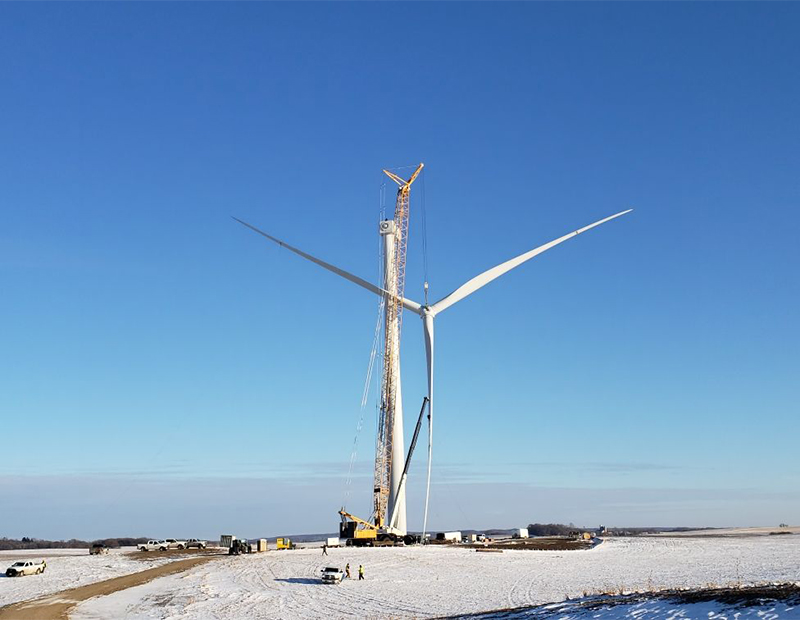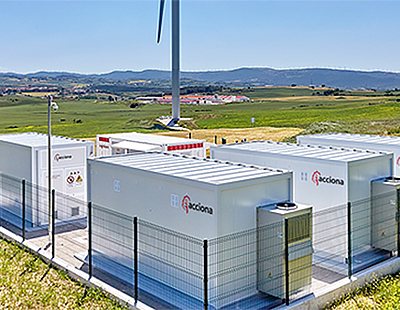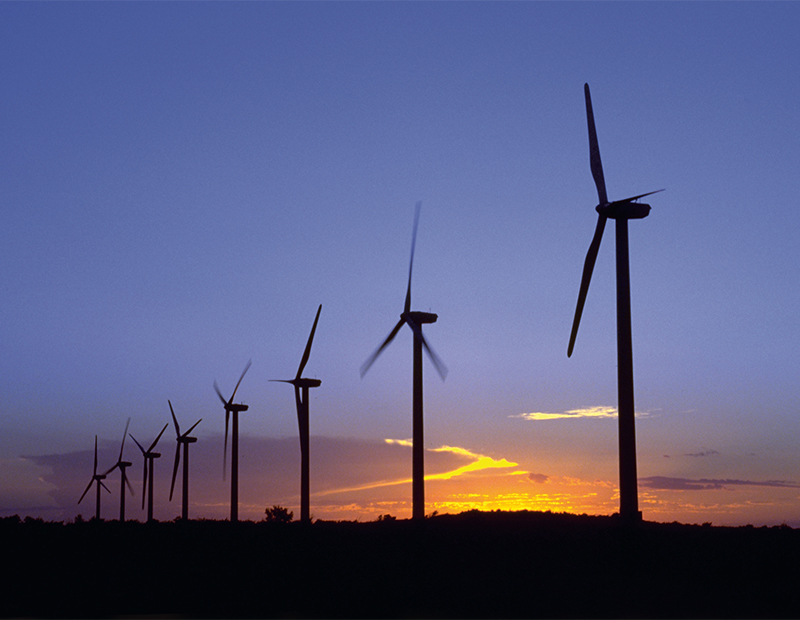Where Generation Meets Innovation
Nine promising initiatives from the U.S. and abroad point to the future of power, procurement and clean energy.
In the quest for 21st-century solutions to the world’s energy challenges, an unprecedented coalition is coming together: real estate developers, energy providers, technology companies and many others. Their novel strategies are unfolding on land, at sea, and even in cyberspace. Following are nine promising initiatives that earned plaudits for their ingenuity in 2018.
1. The world’s first floating farm took 16 years to be completed. Hywind Scotland is a 30-megawatt facility developed by Norwegian state-owned Statoil in partnership with Masdar and has a generating capacity able to power about 20,000 U.K households. Located off the shore of Peterhead, Aberdeenshire, Scotland, the project consists of five Siemens turbines measuring 584 feet high and 505 feet in diameter, each tethered to the seabed. The most exciting thing about Hywind is that floating turbines can be sited in much deeper water than conventional offshore wind farms (typically restricted to waters up to a depth of 197 feet). Floating wind farms can operate in water up to 450 feet deep, which offers great potential for energy producers.
2. The Ciel & Terre Hydrelio facility is the first public solar power system installed in California. The 252kWh photovoltaic power system consists of 720 floating solar panels mounted together and floats on a man-made wastewater treatment pond in Kelseyville. Besides not requiring real estate to build it on, the project is a suitable solution for any utility district as it couples clean energy generation with water conservation benefits. Floating a solar array not only improves the energy production as water keeps the solar system cooler, but also reduces evaporation and controls algae growth and reduces water movement to minimize bank erosion.
3. The first commercial integrated solar-wind hybrid power generation project in the U.S has a capacity of 2 megawatts and is located in Minnesota. Juhl Energy’s project comprises one 2.0-116 wind turbine supplied by GE Renewable and 0.5MW of photovoltaic solar. Using GE’s Wind Integrated Solar Energy (WiSE) technology platform, the system integrates the solar panels through the wind turbine’s converter so both wind and solar share the same balance of plant, which increases its net capacity by 3-4 percent, and annual energy production by up to 10 percent. The main takeaway of the system is its ability to produce power when it is most needed—solar providing summer peak energy, and wind providing winter peak energy.
4. Chattanooga, Tenn., holds the distinction of hosting the world’s only auto manufacturing plant ever to earn LEED Platinum certification. While the certification was given in 2011, last year Volkswagen Chattanooga received the Environmental Excellence award. Upward of 800,000 vehicles have been produced at the facility, yet energy strategy is one of its highlights: Volkswagen company developed a 33-acre solar park consisting of 33,600 solar modules that generate more than 13 gigawatts of electricity annually. Some 1.2 million kilowatts a year are saved through the installation of T5 light bulbs throughout the facility.
5. Blockchain technology certifies green energy in Navarre, Spain, with ACCIONA Energia as the initiator. The company can certify the renewable origin of energy from two facilities: a 3-megawatt Nordex AW116/3000 wind turbine at Barasoain equipped with a storage system with two batteries (a fast-response 1-megawatt/0.39-megawatt-hour model, plus a 0.7-megawatt/0.7 megawatt-hour battery with greater autonomy), and a photovoltaic farm near Tudela with a storage system with a 1-megawatt battery.
6. Prescriptive Data’s Nantum IoT solution, a cloud-based building operating system powered by Intel, gives property owners the ability to save on expenses and optimize operational efficiency, while improving tenant retention. Nantum acts like the brain of the building: it integrates with existing building systems as well as third-part apps with open APIs and through a combination of local data harvesting and direct-cloud connected hardware, it captures and stores real-time data from building subsystems.
It’s a natural response to market demand for a next-generation building management platform that combines institutional knowledge with data-driven insights from IoT, big data and artificial intelligence. Rudin Management Co. is using the software in 17 of its New York City assets, 15 commercial properties and two residential towers, and reported that results show an overall carbon emissions reduction of more than 40 percent in several areas including electric and steam consumption.
https://www.youtube.com/watch?v=NI0sbiCNXtA
7. The North Sea Wind Power Hub, also called Power Link Islands, is a planned structure off the coast of Northern England estimated at $1.8 billion. This man-made island will be built on Dogger Bank, a 62-mile sandbank in a shallow area of the North Sea, between 78 miles and 180 miles off the east coast of Yorkshire. Its sponsor is the Dutch company TenneT. Six North Sea countries are partners in the project: the Netherlands, Belgium, Norway, Germany, Denmark and the United Kingdom.
The project provides solutions to the usual logistical and technological problems all wind farm developers face: those closer to shore have limited capacity due to lower wind speeds and limited space, while those farther offshore are not cheap to maintain. Moreover, remote wind farms require more expensive direct current cables, as alternating current loses too much power over long distances. The first phase of the project, anticipated for completion in 2023, consists of the addition of more than 3.5 gigawatts of wind energy. The second phase will roll out throughout 2024-2050 when the island itself will be built, as well as boost the installed wind capacity by 100 gigawatts. From that point on, the capacity could be increased by adding one or several more modules.
8. The concept of Virtual Power Plants (VPPs) is relatively new. Its name, although confusing as there is hardly anything virtual about steel, silicon and lithium on the ground, stands for a system that integrates several types of power sources to provide a reliable overall power supply, unlike conventional power plants, which use a single generation technology—such as hydraulic turbines, photovoltaic panels and steam turbines. Even though they might seem similar to combined-cycle power plants—because these use both gas and steam turbines—they are different as combined-cycle power plants have gas combustion as heat source for both types of turbines.
Perhaps a better term, adopted by some, is “Internet of Energy” as these systems utilize existing grid networks to tailor electricity supply and demand services for customers. VPPS can be configured with any mix of energy resources, linked using information technologies and operated in coordination like a utility-scale power station. One of its advantages over conventional power plants is that in the event of a faulty generation system connected to the VPP, there will only be a very small loss of capacity, unlike conventional power plants—these need to be brought offline is a key component suffers a fault. According to a new research report published by P&S Market Research, the nascent VPP market is projected to reach $5.5 million by 2023.
9. Virtual Power Purchase Agreements (VPPAs) are slowly but surely replacing the physical PPAs, the dominant form of transaction in the early years of the corporate renewable energy market. This new form of contract enables the corporate buyer to have access to renewable energy without owning or being responsible for the physical electrons generated by the project.
It is purely a financial arrangement, exchanging a fixed-price cash flow for a variable priced cash flow and renewable energy certificates (RECs). VPPAs are scalable and help buyers satisfy a large portion of their sustainability goals, with a number of deals. For example, Cinemark USA, a wholly owned subsidiary of Cinemark Holdings, has signed a nine-year VPPA with a subsidiary of American Electric Power for 40 megawatts from AEP’s Trent Mesa wind energy center in Nolan County, Texas. This capacity will produce renewable energy enough to power about 120 Cinemark theaters.










You must be logged in to post a comment.